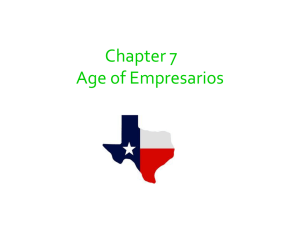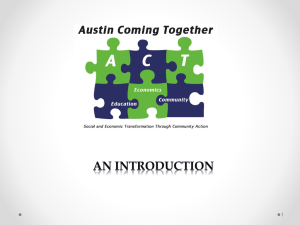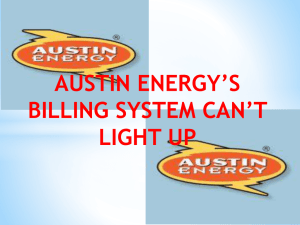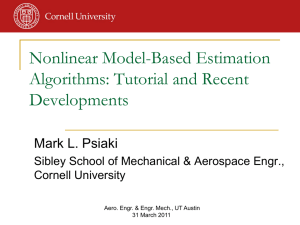Comparisons of Travis County and City of Austin Economic
advertisement
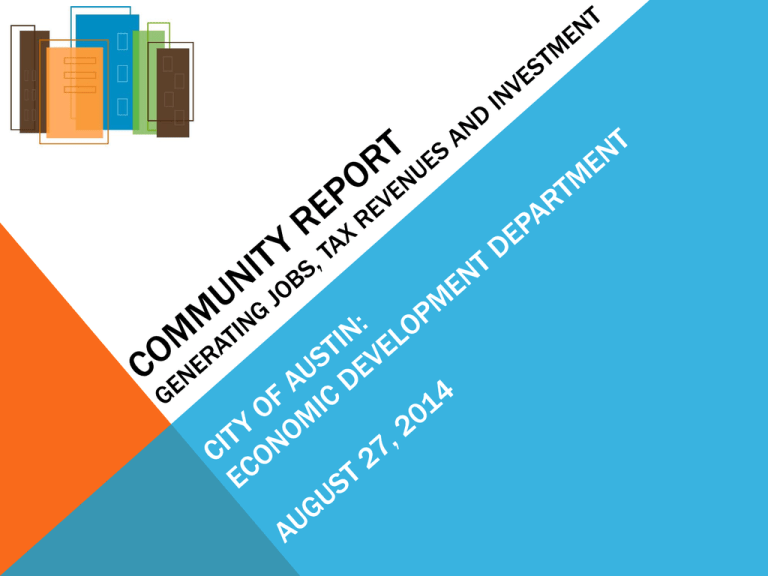
STRATEGIC INITIATIVES: ECONOMIC DEVELOPMENT DEPARTMENT Global Business Recruitment and Expansion •Business Expansion •Development of Eco-Industrial Park •International Trade and Investment •International Welcome Program •Sister & Friendship Cities •Technology Incubators •Workforce Development •Creative Content Program •Creative Ambassadors Program Cultural Arts Division •Cultural Funding •Cultural Tourism •Arts Marketing •Art in Public Places •Public Art Restoration •Creative Industries Development •Film, TV and Digital Media Support •Cultural Planning •Creative Space Development & Creative Placemaking •The People’s Gallery Exhibition Small Business Development Program •Family Business Loan Program •LocallyAustin.org •BizAid Business Skills Classes and Certification •Partnership with Austin Public Library •BizOpen •Business Solutions Center •Getting Connected & Meet the Lender Redevelopment Division •Mueller •Seaholm District •2nd Street •Green Water Treatment •Downtown Redevelopment •Commercial Revitalization Strategy Music and Entertainment Division •Austin Music Industry Census 2014 •Austin-Toronto Music City Alliance •Austin Independent Radio •Music Venue Assistance Loan Program •Music Ambassadors •Outdoor Music Venue, Temporary & Special Event Permit Assistance •HopeFM First Live Sundays •Music for Kids 2 PURPOSE • Focus for Economic Development • • • • Goals Challenges Opportunities Solutions 3 FOCUS FOR ECONOMIC DEVELOPMENT: THE 4 GOALS Implement the Imagine Austin Plan by diversifying the economy: 1. Address inequity and poverty by creating jobs for the hard to employ. 2. Use our cultural diversity as an economic strength, locally and internationaly. 3. Attract high-tech industrial companies and logistics businesses. 4. Expand local small businesses citywide as a revitalization and hiring strategy. 4 FOCUS FOR ECONOMIC DEVELOPMENT: THE CHALLENGES • Individuals and Families in Poverty • Hard to Employ Populations • The Underemployed • The Rising Cost of Living in Austin • Demographic Trends 5 CHALLENGE NUMBER 1: POVERTY • Over 19 percent of all residents in Austin live in poverty.1 • From 2000 to 2011, the Austin metropolitan area recorded the nation’s second fastest increase in the number of poor people living in suburbs.2 • The rate of child poverty is disproportionately high, reaching 27.2 percent in 2012.3 • Just over 60% of the local public school system children rely on subsidized lunches or other public assistance, a clear indicator of family income, stress, and an important factor in youth education.4 Sources: 1 US Census Bureau, 2008-2012 American Community Survey 5-Year Estimates 2 http://www.mystatesman.com/news/news/local/poverty-takes-root-in-austins-suburbs/nXwt2/ 3 US Census Bureau, 2008-2012 American Community Survey 5-Year Estimates 4 http://www.austinisd.org/legislature/about-austinisd. Accessed January 29, 2014. 6 CHALLENGE NUMBER 2: HARD TO EMPLOY • Pool of approximately 10,000 individuals in Austin. Hard to employ for different reasons. • • • • Drop-outs Former convicts Individuals with language barriers The homeless • These populations include individuals that require the most social services, and their employment and self-sufficiency will make a broad impact socially and economically. 7 CHALLENGE NUMBER 3: UNDEREMPLOYED • Population includes: • Those employed part-time but seeking full-time employment. • Those employed at jobs with responsibilities below their level of skill or education. • 53.6% of undergrads under 25 were unemployed or underemployed in the US in 2012, according to researchers at Northeastern University and Drexel1 • Humanities majors “were among the least likely to find jobs appropriate to their education level” • Most likely? Healthcare, education, accounting, computer science • Up to 800 veterans transition out of military service per month from Fort Hood. Sources: 1 http://www.nbcnews.com/id/47141463/ns/business-stocks_and_economy/#.UumUQxBdVCZ 8 CHALLENGE NUMBER 4: AFFORDABILITY • As Austin grows in popularity and becomes a more desirable place to live, market forces result in higher prices for housing and other scarce resources: • Consider: Austin is the third fastest-growing city in the US.1 • From 2001 to 2010, real annual pay in Travis County increased by nearly 1%, and wages barely outpaced inflation.2 • Austin now has the highest rent in the state of Texas.3 • 2008 study found that 37,600 renters earning less than $20k per year lacked housing stock, even after accounting for subsidized unit and vouchers. 4 Sources: 1 US Census 2000, US Census 2010 2 Chart, “Travis County Wages, CPI-U,” April 30, 2012 (researched by Austin economist Stuart Greenfield) 3 Texas Department of Housing and Community Affairs 4 http://www.ci.austin.tx.us/housing/downloads/austin_comprehensive_housing_market_study.pdf 9 CHALLENGE NUMBER 5 DEMOGRAPHIC TRENDS The changing face of Austin: • White, non-hispanic share of total population has dropped below 50% • Hispanic population is currently 35% and is estimated to equal the white, non-Hispanic population in 25 years • Growth rates of Latino and Asian households far exceed the growth of white households • African-American population has dropped to 8% • 19.1% of Austinites are foreign born • Austin has a young median age (31) • The absolute number of children continues to grow 10 FOCUS FOR ECONOMIC DEVELOPMENT: THE OPPORTUNITIES Technological Progress and Adoption • Lack of diversity in science and technology based industries: • Hispanics make up 7% of STEM workforce.² • Women make up 26% of the STEM workforce.² • Culture is an economic asset that could be leveraged for outreach and service delivery models to reach all constituents. • Economic development initiatives to align the growing populations of our city with the future of industy development and job creation. • Strong relationships with minority chambers for outreach and exchange. • 9,000 jobs being created in Austin Tech Industry over the next 3 years.³ Sources: 1 Austin-Round Rock-San Marcos MSA Job Market Report, Austin Chamber of Commerce. 2 Indicates national figures for STEM employment. 3 Austin Technology Council Annual Presentation to Council. 11 FOCUS FOR ECONOMIC DEVELOPMENT: THE SOLUTIONS • Stabilize inner city areas through commercial revitalization strategies • Evolution of a world-class workforce through: • STEM initiatives and industry interaction • Occupational development providers like Capital Idea and Skillpoint Alliance • Expand small business, technology manufacturing and logistics industries • International relationships for trade and commerce: • Hackney, Mexico City and Sister Cities • International Association of Science Parks • Creative Ambassadors • Business recruitment efforts through Opportunity Austin 3.0 • Incentives program • Predictive Analytics 12 REDEVELOPMENT: PUBLIC-PRIVATE PARTNERSHIPS SEAHOLM DISTRICT City Public-Private Projects Produced: • • • • • • • • • • 3,675,000 SF Total 2,280 Residential Units 630,000 SF Office 193,000 SF Retail/Restaurant/Hotel $1.3B Total Construction Value $52.9M 30-year accumulated property tax revenue Transportation Infrastructure Public Parking Open / Green Spaces Public Art 13 REDEVELOPMENT: PUBLIC-PRIVATE PARTNERSHIPS MUELLER Mueller Today (nearing 40% completion): City Public-Private Projects Produced: • $157 M under construction in 2014 •3,675,000 SF Total Product • Diversity: wide rangeNew of housing types and jobs •2,280 Residential Units Required • 25% Affordable Housing •630,000 SF Office homes (1,475 at completion) • 637 affordable •193,000 SF Retail/Restaurant • Almost 5,000 residents (13,000 at completion) •Boutique Hoteljobs (13,000 at completion) • Almost 5,000 •Multimodal Infrastructure • 75 acres ofTransportation new parks (140 at completion) •Public Parking • Sustainable Results to Date: •Open / Green Spaces waste diverted • 89% of construction •Public Art • 42% energy use reduction 14 CREATED BEST PRACTICES FY 2013-14 1. ArtPlace America Grant Cultural Arts Division won a Nationally Competitive Grant from ArtPlace America for $400,000 along with community partners, Fusebox and thinkEAST, to create a 24-acre Art Village on a former tank farm 2. ArtPlace America Grant Cultural Arts Division won a Nationally Competitive Grant from ArtPlace America for $256,500 along with community partner, GO collaborative, to map art assets in the new 10 Council districts to expand and revitalize retail areas citywide 3. $1M EDA Grant to Create 1st Eco-Industrial Park Partnership with Austin Resource Recovery to create 1st Eco-Industrial Park. Obtained a $1 million grant from the U.S. Economic Development Administration (EDA) to convert city landfill to [re]Manufacturing Hub 4. Small Business Customer Solutions Education Platform Partnership with Planning and Development Review to create an electronic customer service solution geared at small businesses seeking building permits. Using BazaarVoice technology, this is the 1st public use of private sector customer service technology 5. Family Business Loan Program providing 1.5% low interest loans to local businesses 6. International Strategic Economic Plan to capitalize on global trade with 10 science cities worldwide 15 Thank you Kevin Johns, Director City of Austin Economic Development Department Visit us at www.austintexas.gov/edd





